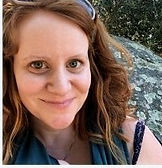
KNOT Magazine
Fall Issue 2022
#Disabled AF Instagram Revolution by Rae Rose
According to a search on Google images, “bipolar mother” is a disaster: women with their head in their hands and crying children in the corner. As a pregnant, bipolar woman, I googled this a lot, terrified that my first psychiatrist was right and I should have never gotten pregnant. I was also following Elsie Larson’s (of A Beautiful Mess and the app A Color Story) entry into motherhood. She adopted a girl with albinism from China. They painted together, giggled together – they were what I wanted to look like with my little girl. I decided that when I had my baby I would try to Elsie Larson it and forget about those scary images. I joined Instagram. I don’t know what typical people are doing on Instagram – I see a lot of pictures of food or something? -- but we’re having a revolution.
Popular hashtags like #disabledandcute and #disabledandsexy mean that a diverse group of people with disabilities – different genders, nationalities, etc – are both calling their bodies sexy with the same link, so all of these different people are connected by disability. Hulya Marquardt, sums it up as simple. “It’s not just about Instagram,” she notes. She finds a correlation between the numbers of pictures one is able to see and the degree of acceptance they embrace. “It becomes normal,” Marquart told me. “People get used to seeing other people in wheelchairs or with missing limbs.” Images are important. Karlis Podnick, a paraplegic basketball player, was used to seeing photos of the people he wanted to emulate, images that inspired him. “As an athlete, I always have had examples. So I try to be that example now. Instagram gives me a way bigger platform to be an example for a bigger audience.”
Elise Larson is proving Marquardt and Podnick correct. Traffic to her blog, when she announced she was adopting another baby, also with albinism, crashed her site. Though Larson talks openly about albinism, no one is obsessed with her daughter’s disability. Larson has normalized it with a bazillion images on Instagram. We’re obsessed with her pig tails, bell bottoms and stuffed pigs – all named Piggy.
I also experienced what Ben, who calls himself your friendly paraplegic,” experienced after I had what I thought would be an easy med change. He says, “Having the platform to do this has really helped – not only others but myself, giving me the opportunity to learn about myself and my abilities.” During the spooky days of my med change I removed myself from my daughter for her safety, and I turned to Instagram for support. I didn’t post happy pictures or pretend it wasn’t happening. I published things like what if felt being in a “bipolar middle,” the middle of a possible relapse, pictures of what my housed looked like during a recovery day (including a bowl of peanut butter on the printer) and a list of my med change mistakes and what someone should do differently. I felt supported, heard, and frankly, loved. Michele Griffith, self employed, explains it this way: “Those with disabilities learn what it’s like to live with other disabilities…It’s an amazing supportive community. They truly understand your struggles, victories, frustrations, excitements. It’s incredible!”

Rae Rose is a poet living in Southern California, with her husband and daughter, nicknamed Elro. She raises plants and caterpillars. Her book, Bipolar Disorder For Beginners, was published in 2013 and a book of poetry she edited entitled Kids! San Diego Poetry Annual launched last year. They are both available on Amazon.
Please contact Rae Rose at raeroselarkbloom@gmail.com.
